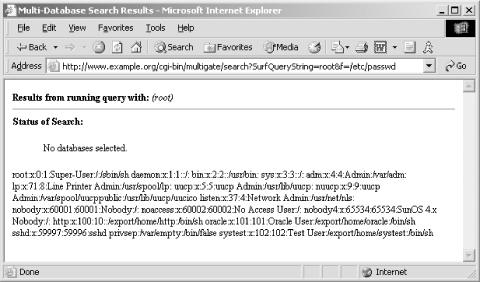13.1 The Fundamental Hacking Concept
| Hacking is the art of manipulating a process in such a way that it performs an action that is useful to you. A simple example is to look at a search engine; the program takes a query, cross references it with a database, and provides a list of results. Processing occurs on the web server itself, and by understanding the way search engines are developed and their pitfalls (such as accepting both the query string and database filename values), a hacker can attempt to manipulate the search engine to process and return sensitive files. Many years ago, the main U.S. Pentagon, Air Force, and Navy web servers (http://www.defenselink.mil, http://www.af.mil, and http://www.navy.mil) were vulnerable to this very type of search engine attack. They used a common search engine called multigate, which accepted two abusable arguments: SurfQueryString and f. The Unix password file could be accessed by issuing a crafted URL, as shown in Figure 13-1. Figure 13-1. Manipulating the multigate search engine High-profile military web sites are properly protected at network level by firewalls and other security appliances. However, by the very nature of the massive amount of information stored, a search engine was implemented, which in turn introduced vulnerabilities at application level. Nowadays, a lot of vulnerabilities are more complex than simple logic flaws. Stack, heap, and static overflows, along with format string bugs, allow remote attackers to manipulate nested functions and often execute arbitrary code on accessible hosts. |
EAN: 2147483647
Pages: 166